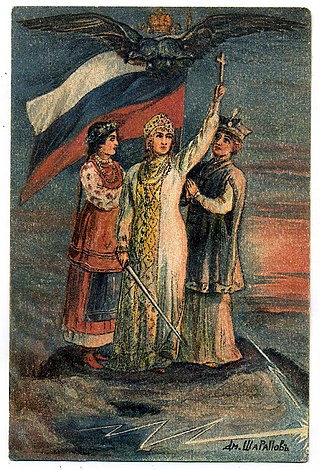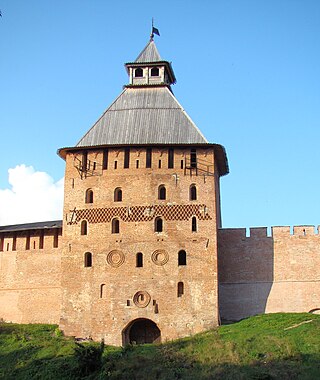A kremlin is a major fortified central complex found in historic Russian cities. The word is often used to refer to the Moscow Kremlin and - metonymically - to the government based there. Other such fortresses are called detinets, such as the Novgorod Detinets.

Ukrainian is an East Slavic language of the Indo-European language family, spoken primarily in Ukraine. It is the native language of Ukrainians.

Knyaz, kniaz or knez is a historical Slavic title, used both as a royal and noble title in different times of history and different ancient Slavic lands. It is usually translated into English as prince or duke, depending on specific historical context and the potentially known Latin equivalents of the title for each bearer of the name. These translations probably derive from the fact that the title tsar was often treated as equivalent to "king" by European monarchs. In Latin sources the title is usually translated as princeps, but the word was originally derived from the common Germanic *kuningaz (king).

Old East Slavic was a language used during the 5th–16th centuries by the East Slavs from which the Belarusian, Russian, Rusyn, and Ukrainian languages later evolved.

The Principality or, from 1253, Kingdom of Galicia–Volhynia, historically known as the Kingdom of Ruthenia, was a medieval state in Eastern Europe which existed from 1199 to 1349. Its territory was predominantly located in modern-day Ukraine, with parts in Belarus, Poland, Moldova, and Lithuania. Along with Novgorod and Vladimir-Suzdal, it was one of the three most important powers to emerge from the collapse of Kievan Rus'. The main language was Old East Slavic, the predecessor of the modern East Slavic languages, and the official religion was Eastern Orthodoxy.

The Russkaya Pravda was the legal code of Kievan Rus' and the subsequent Rus' principalities during the times of feudal division. It was written at the beginning of the 12th century and remade during many centuries. The basis of the Russkaya Pravda, Pravda of Yaroslav was written at the beginning of the 11th century. The Russkaya Pravda was a main source of Kievan Rus' law.

Bilhorod Kyivskyi or Belgorod Kievsky was a legendary city-castle in Kievan Rus', on the right bank of the Irpin River, that was mentioned in chronicles.
Originally, the name Rus' referred to the people, regions, and medieval states of the Kievan Rus'. Its territories are today distributed among Belarus, Northern Ukraine, Eastern Poland, and the European section of Russia. The term Россия (Rossija), comes from the Byzantine Greek designation of the Rus', Ρωσσία Rossía—related to both Modern Greek: Ρως, romanized: Ros, lit. 'Rus'', and Ρωσία.


The Rurikids or Riurikids also known as the Volodimerovichi, were a noble house allegedly founded by the Varangian prince Rurik, who, according to tradition, established himself in Novgorod around the year AD 862. After the conquest of Kiev by Rurik's successor Oleg the Wise in c. 880, the Rurikids established a dynasty over the state of Kievan Rus' until its disintegration in the 12th and 13th centuries. Over time, the reigning house split into many different branches, with distinct branches ruling regional centers. They continued to rule in many of the Rus' principalities which evolved out of Kievan Rus'.

Veliky Novgorod, also known as Novgorod (Новгород), is the largest city and administrative centre of Novgorod Oblast, Russia. It is one of the oldest cities in Russia, being first mentioned in the 9th century. The city lies along the Volkhov River just downstream from its outflow from Lake Ilmen and is situated on the M10 federal highway connecting Moscow and Saint Petersburg. UNESCO recognized Novgorod as a World Heritage Site in 1992. The city has a population of 224,286 (2021 Census).

Kolt or kolty was a part of a female headgear, hanging on a ryasna at both temples as a sign of family's wealth, common in 11th-13th centuries in Old Rus'. It comprised a pair of metal pieces, joined to form a hollow medallion or star that, presumably, contained a piece of cloth, impregnated with fragrances.

The All-Russian nation or triune Russian nation, also called the pan-Russian nation, is the term for the Imperial Russian and later irredentist ideology that sees the Russian nation as comprising a "trinity" of sub-nations: Great Russia, Little Russia, and White Russia. Respectively, these sub-nations are contextually identified with Russians, Ukrainians, and Belarusians. Above all, the basis of the ideology's upholding of an inclusive Russian identity is centred around bringing all East Slavs under its fold.

Church Statute of Prince Volodimir is a source of church law in Old Rus', defined legal authority of church and legal status of clergy by the state: prince (knyaz) and his administration. Vladimir's Statute was a short legal code, regulated relationship between the church and the state, including demarcation of jurisdiction between church and princely courts, and defined index of persons and organizations within the church jurisdiction. The church also got under its supervision the system of weights and measures, and monthly support: tithe from all princely income. The statute was written at the beginning of the 12th century and remade during many centuries. The statute was written in Old Church Slavonic and Old East Slavic. It was one of the first church sources of Kievan Rus' law. The Church Statute of Prince Yaroslav and other Kievan Rus' princely statutes served closely related purposes. One of the sources of the statute was Byzantine law, including the Kormchaia.

Kievan Rus' law or law of Kievan Rus', also known as old Russian law or early Russian law, was a legal system in Kievan Rus', in later Rus' principalities, and in the Grand Duchy of Lithuania from the 13th century. Its main sources were early Slavic customary law and Zakon Russkiy, which was partly written in Rus'–Byzantine Treaties. A number of articles have similarities with the Germanic (barbarian) laws, for example, the "Salic law" – a collection of legislative acts of Francia, the oldest text of which dates back to the beginning of the 6th century. The main written sources were Russkaya Pravda and Statutes of Lithuania.

Rus' chronicle or Russian chronicle or Rus' letopis was the primary type of Rus' historical literature. Chronicles were composed from 11th to 18th centuries, generally written in Old East Slavic about Kievan Rus' and subsequent Rus' principalities and histories. Chronicles were one of the leading genres of Old Rus' literature, and were prominent in medieval and early modern Eastern and Central Europe.
The Ukrainian hryvnia has been the national currency of Ukraine since 1996. It was briefly used in the Ukrainian People's Republic before the karbovanets was adopted as a national currency. The hryvnia is named after the grivna, which was used in Kievan Rus'.

Dytynets Park (Chernihiv) is the most ancient area of Chernihiv. It is a hill on the bank of the Desna River, where a defense complex is situated. Walking along the alleys of the park, you can feel the spirit of ancient times, marvel at the panorama of the Boldyna Hora, see the numerous churches and cathedrals, and observe the whole city. At the viewing point, there are 12 cast-iron bastion cannons from the seventeenth century, which are the calling card of the city. By the way, Dytynets is a perfect spot to have a lunch in one of the traditional cuisine restaurants.

Bishop Street was the main street of the Novgorod Detinets in the Middle Ages. The street was buried by the 18th century, its precise location is a subject of considerable historical and archeological research.
















